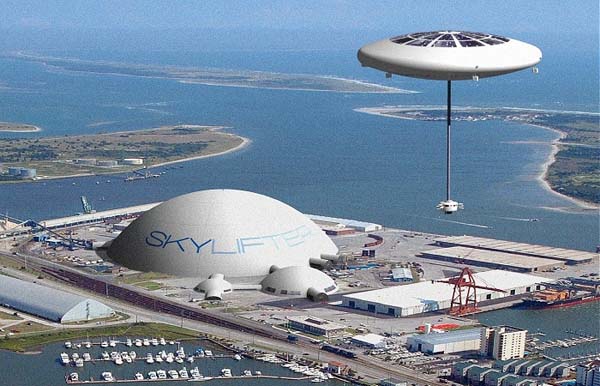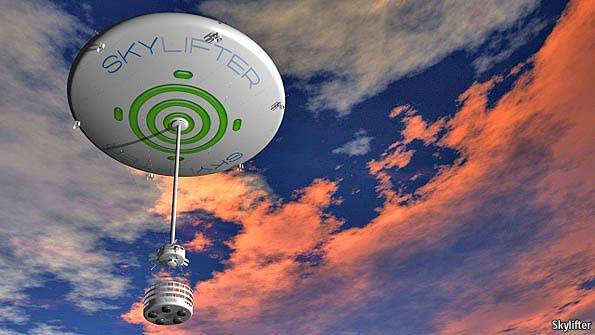Flying Saucers delivering people and provisions?
Source: economist.com

Transporting large, clunky bits of equipment has always posed a challenge. Roads and railways do not reach everywhere, and even if they did, many cumbersome and heavy constructions need to be hauled in pieces, only to be put together at the final destination. Aeroplane cargo faces even tighter restrictions on shape and size, not to mention the need for runways. Heavy-transport helicopters, such as the Mil Mi-26 or Sikorsky S-64 Skycrane, address some of these difficulties, but their payloads are limited to 20 and nine tonnes, respectively, and the huge rotors create a powerful downdraft that makes handling that payload rather tricky. So people have long been looking for other ways round the problem. Now, Skylifter, an Australian aeronautical firm, thinks it has found the perfect solution.
The company is developing a piloted dirigible capable of carrying loads of up to 150 tonnes over distances as great as 2,000km (1,240 miles) at a speed of 45 knots (83kph). This would permit the craft to transport not just hefty components, but entire buildings, to remote areas. The company envisages modules ranging from rural hospitals and disaster-relief centres to luxury airborne cruise ships.

SkyLifter and assembly hangar Skylifter.com.au
Rather than use either a spherical or a cigar-shaped aerostat, as the gas-filled envelope of a lighter-than-air craft is known, Skylifter has developed a discus-shaped one. This means that like a traditional, round ballon—and unlike the elongated dirigible blimps that have hitherto been used as serious modes of commercial transport—the craft is “directionless”. In other words, it is oblivious of where the wind happens to be blowing from, which simplifies load-handling in places where the wind is fickle. At the same time, being flatter than a sphere, the aerostat acts less like a sail than a traditional balloon does, making it easier to steer. The flying-saucer shape also acts as a parachute, affording greater control during descent.
Video from: YouTube.com
Skylifter’s other innovation is to use devices called Voith-Schneider propellers instead of airscrews. A Voith-Schneider propeller is similar to a paddle wheel, but has hydrofoil-shaped blades instead of flat ones. Speeding up the propeller’s rotation increases its thrust, while shifting the blades’ angles changes the direction of the thrust. A Voith-Scheneider propeller thus provides power and steering at one and the same time. Skylifter plans to use several such drives to control the craft’s horizontal motion, and also to aid a buoyancy-control system within the envelope in moving the vehicle up and down.
Finally, by dangling the control pod well below the aerostat, the whole craft’s centre of gravity is shifted downward. This makes it less wonky, without the need for additional stabilisers—which bring extra weight.
The firm has already built a remote-controlled test version, named Betty, to demonstrate how the basic arrangement would work. Betty’s helium-filled aerostat, three metres across, is capable of carrying loads of a little over half a kilo—though for now her power comes from a standard airscrew fitted on a suspended control pod. The company has also scaled up the aerostat itself to the 18-metre-wide Vikki. This model, however, remains tethered to the ground at all times, as it has not been equipped with a propulsion system.
Skylifter’s engineers are now working on a 23-metre unmanned version dubbed Nikki. They plan to construct a full-sized 150-metre piloted prototype, Lucy, over the next three years. If that works, Skylifter craft may yet bring relief to stranded disaster victims—and also to jaded millionaires sick of ocean liners.
Article from: economist.com






















